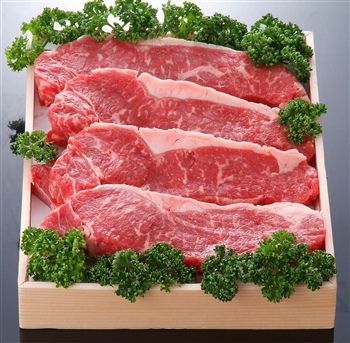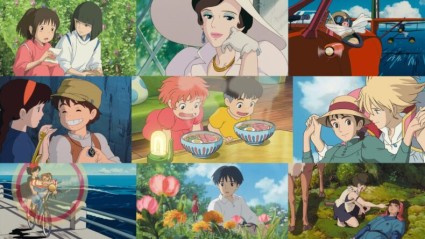“Any of us would kill a cow, rather than not have beef.”
While it’s unlikely that too many people nowadays would put Samuel Johnson’s words into practice, steak lovers around the world can relate to the 18th century author’s passion for beef.
You certainly won’t be left chewing your cud on the streets of Tokyo. In a nation known for its voracious appetite for fish, meat eaters have forced a sea change: in 2006, for the first time ever, the Japanese consumed more meat than seafood. As any Tokyo resident knows, every neighborhood is filled with joints offering gyudon, yakiniku, sukiyaki, beef stew, hamburgers (or the bunless "hambagu"), kebabs and steak—both Western and the much-revered wagyu.
In addition to domestic producers and massive beef-exporting nations like Australia and the U.S., smaller exporters such as Canada, Mexico, New Zealand and Vanuatu are staking their claim to the multi-billion dollar Japanese beef market.
Yet look beyond the red-meat frenzy, and you see signs of trouble. In 2003, the discovery of U.S. beef infected with BSE (aka mad cow disease) led Japan to place a blanket ban on American imports. Domestically, an outbreak of foot-and-mouth disease in Miyazaki in April forced local officials to declare a state of emergency, and led to a cull of nearly 300,000 cattle and pigs. Throw international trade frictions into the mix, and the Japanese beef scene leaves plenty to digest.
Historically speaking, the biggest impact on meat consumption in Japan came with the introduction of Buddhism in the 6th century. Emperor Tenmu (631-686), in line with Buddhist teachings, outlawed the eating of four-legged animals in 675. Backed by legislation, this practice became widespread over the next few centuries, and except for a few foreign enclaves, remained in place until the fall of the Tokugawa Shogunate in 1868.
While the newly installed Emperor Meiji was known to regularly dine on beef and mutton, most people still wouldn’t eat cattle, as the beasts were used primarily as draft animals for rice production—making them sacred cows of a sort.
Mechanized rice harvesting took root in the 1950s, leaving cattle out of work and, perhaps inevitably, fattened up for eating. At the same time, stringent import restrictions on agricultural products, including beef, kept much foreign meat out of the country and helped maintain relatively low consumption levels. The average Japanese ate just 4.2 kg of beef per year between 1962 and 1991, compared with 32.39 kg of fish.
That all changed when the market was liberalized in the mid-1980s. In June 1988, Australia, the U.S. and Japan signed the Japanese Beef Market Access Agreement, which replaced quotas with tariffs and led to a huge rise in imported beef. According to finance ministry statistics, imports jumped from 11,864 metric tons in 1976 to 106,556 tons in 1988 and 348,299 tons in 2000. Per capita consumption, meanwhile, skyrocketed to a peak of 10.2 kg in 2002.
Australia is dominant market player
By 2001, Australia and the U.S. had an identical share of the Japanese market—both countries imported 285,000 tons of beef during the fiscal year. Yet since the ban on U.S. beef took effect in 2003, the Australians have become the world’s dominant player.
The U.S., however, is fighting back. In an attempt to restore consumer confidence in American meat, Tokyo and Washington implemented a Beef Export Verification program in 2006 to certify that U.S. exports meet Japan’s BSE-related requirements. The program restricts imports to certain cuts of beef, but more importantly, it only permits the U.S. to export beef from cows aged 20 months or less—young cattle being considered less susceptible to BSE.
“Although the ban has been lifted, current restrictions are having a significant effect on trade,” a U.S. Embassy official tells Metropolis. “U.S. beef exports to Japan prior to these measures were over four times the current level… The age restriction poses the single greatest hurdle facing U.S. beef exports to Japan. However, there is a very strong demand for U.S. beef in Japan, so we maintain a positive outlook with the assumption that Japan will address these restrictions.”
And, indeed, there are signs that the curbs may soon be relaxed. According to recent reports, Japan and the U.S. will likely resume talks on the issue as early as next month. Washington will almost certainly push for a softening of the age rule, and government sources point to a possible increase of the minimum age to 30 months.
When the mad cow scare took a big bite out of US beef imports, many restaurants and supermarkets embraced the Aussie alternative.
“We only use Australian beef,” says Satoshi Ueda, operating partner of the Outback Steakhouse chain in Japan. “We used to use U.S. beef, but switched to Australian after the BSE outbreak because consumers were concerned.”
Ueda hints, however, that this policy is not permanent: “We are considering using U.S. beef again in the future. U.S. beef has more marbling and tenderness, whereas Australian beef is a redder meat that is a little tougher. Some customers prefer U.S. beef, and some prefer Australian.”
Atsushi Kugue, PR manager of the Japanese arm of Meat & Livestock Australia, sees beef from Down Under playing a vital role in Japan.
“Australia was already a major supplier of imported beef to the Japanese market when BSE was discovered in the U.S.,” he says. “Australia helped fill the gap left by the United States’ absence. Japan needed safe beef, and Australia did its best to meet demand.”
Australia supplies beef to all segments of the Japanese market, including retail shops, restaurants and schools. In fact, a majority of beef served at gyudon and other fast food chains is Australian, and perhaps most significantly, more than 90% of the beef used at that quintessential American icon—McDonald’s—comes from Down Under.
So, does the recent foot-and-mouth crisis offer the same opportunity for growth as BSE did a decade earlier?
“Any disease outbreak such as FMD is of concern to the whole beef industry—whether it be domestic or imported,” Kugue says. “Aussie beef is not a direct substitute for Japanese domestic beef. Consumers regard Australian and Japanese domestic beef as two very different products, and business has continued as usual.”
To many Japanese, the rise of imported beef is a moot issue, because nothing but the famed domestic product will do. Many restaurants, like Sazanka at the Hotel Okura Tokyo, refuse to serve any meat from overseas.
“We decided to use Japanese beef because of customer demands, as we were the first teppanyaki restaurant to open in a hotel [in Japan],” says Kazuhiko Kobayashi, Okura’s food and beverage manager. “Wagyu has intense marbling and is incredibly juicy.”
Despite being significantly more expensive than imported meat, Japanese beef is a must for many foodies in Japan, and the word “wagyu” itself has entered the English lexicon. But consumption of Japanese beef has remained flat over the last decade, with annual production hovering around the 350,000-ton mark.
“Beef consumption is affected more by economic circumstances than meats such as pork or chicken,” says Yuichi Imasaki of the Meat and Egg Division at the Ministry of Agriculture, Forestry and Fisheries. “While domestic production may have dropped because of the foot-and-mouth outbreak in Miyazaki, consumption of beef as a whole has fallen due to the downturn.”
To be sure, the epidemic has devastated beef farmers in Kyushu. But Imasaki prefers to look at the bigger picture.
“The foot-and-mouth outbreak was only in Miyazaki and hasn’t spread across the country,” he says. “Not so many cattle have been culled—only about 68,000 heads. That’s only 2% of the national population. There hasn’t been a direct impact.”
While Imasaki sees the outbreak as only having a limited effect on the domestic beef industry, history shows us that unforeseen events can rapidly turn the market on its head. This leaves both importers and domestic producers of beef on tenterhooks, taking every possible measure to ensure safety—and sate the urges of the carnivorous Japanese consumer.
This story originally appeared in Metropolis magazine (www.metropolis.co.jp).
© Japan Today Take our user survey and make your voice heard.
Take our user survey and make your voice heard.















11 Comments
Login to comment
sk4ek
I have stopped eating beef almost completely in the past few years--aside from a little ground meat in taco or in my spaghetti sauce--not out of any concerns about BSE or other diseases, but because it's simply too expensive, and, as it turns out, certainly not an indispensable part of my diet.
Japan could eliminate many of the problems it has with beef by adopting the practices of one ranch in Hokkaido, which raises its cattle completely naturally--they eat grass! they forage in the woods!--and produces a much redder, meatier product that is safer and far less fatty than traditional wagyu. No drugs, no imported feed (filled with corn, which cows aren't naturally able to digest, not to mention animal byproducts and fillers), no spritzing with wine or beer, no massages, no induced birthing or veterinarian midwives to yank calves from the womb with a chain, as is normally done.
Unfortunately, in the market, wagyu is ranked by degree of marbling--the more the better--so although this beef is tastier, healthier, and better for the environment, it regularly gets ranked a C or C-.
I still get the occasional craving for a nice sukiyaki or sizzling steak, but I think I'll continue to take my chances with chicken. Free-range, if possible.
Zenny11
Being european I naturally tend to eat a lot of pork and poultry.
Beef is not that big a part of our diet, even most of the mince we use is a mixed Beef & Pork.
Granted a like a good steak here and there or some good Biltong(blergh to Beef-jerky).
Don't buy much Beef here anyway unless for stews and than I buy it in blocks. Can't stand the Japanese Marble Beef, got the meat-tenderizer handy in the kitchen.
RedMango
I haven't eaten beef for 40 years - can't say that I miss it
Frungy
... you know where to get Biltong in Japan??!!!! drool
Personally I eat a lot of lamb (also from Australia) and buy it in 4kg blocks from my butcher. I cut and dress it myself at home depending on what I want to use it for.
nchenier
I highly doubt that the majority of beef-eaters would personally kill a cow. That's why it comes packaged and anonymous. No need to muck about in the messy business of slaughtering. For those of you who would (and do) kill your own food, all the power to you, but you're part of the non-hypocritical exception.
Branded
“We used to use U.S. beef, but switched to Australian after the BSE outbreak because consumers were concerned.”
"BSE Outbreak" ??? Since when does one cow constitute an "outbreak" ??? More proof that Japan engaged in a very organized campaign to misinform the public and scare them away from US beef so they could promote Aussie beef from ranches owned by Japanese ranchers ! And Japan wonders why their relationship with the US has soured over the years.
dreamland
Why does Japanese news always fail to report their 36 domestic cases of BSE?
http://www.oie.int/eng/info/en_esbmonde.htm
Pot, meet kettle.
Branded
"Why does Japanese news always fail to report their 36 domestic cases of BSE?"
Because that would constitute..."an outbreak" !!!
MottoMatto
Outback steakhouse is an American-owned, Australian-themed restauarant.
The fact that they can't make up their minds which beef to use only adds to the confusion. I always found it hilarious that they sell deep-fried 'blooming onions' as if they're some kind of Aussie specialty.
I think I'll open up a Texas Roadhouse in Sydney and import lamb from New Zealand.
Sarge
"Any of us would kill a cow, rather than not have beef"
Not me. If I can't get someone to kill the cow, I'l not going to have beef. Same goes for chickens and pigs. I'll catch fish though.
kyoken
What's the difference between killing a fish and --let's say-- a chicken?
Moderator: Back on topic please. The subject is the beef steak industry in Japan.